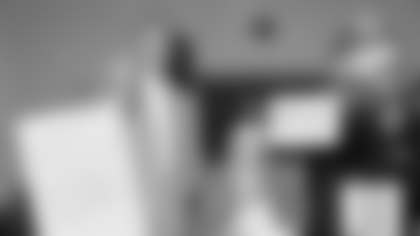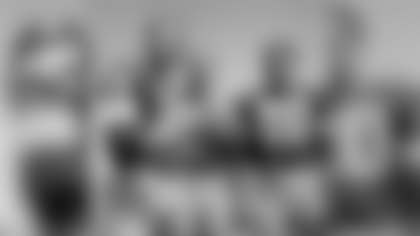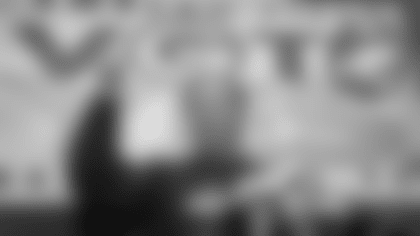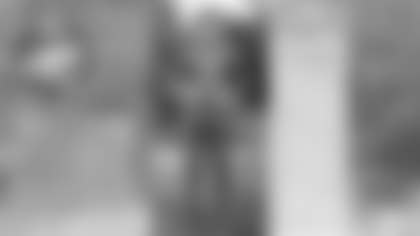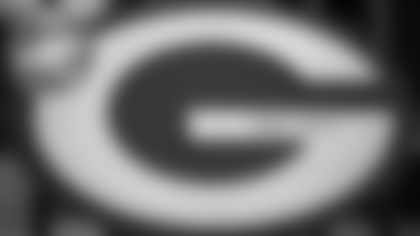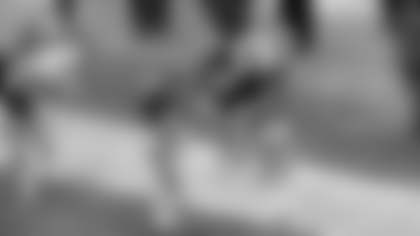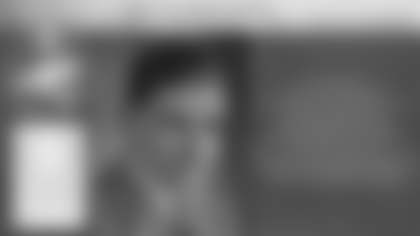Cory from Green Bay
Why in your series on NFL and Packers drafts did you refer to those late 1950s drafts that produced many of Vince Lombardi's best players as Lisle Blackbourn's? Michael Lombardi credits Jack Vainisi for those picks in his book, "Football Done Right."
Because Blackbourn was the head coach and made the picks from the time he was hired three weeks before the 1954 draft through the first four rounds of the 1958 draft, or a little more than a month before he was fired.
From Curly Lambeau in 1936 through Vince Lombardi's final season as coach in 1967, the Packers' head coach had authority over the draft.
Vainisi's title under Blackbourn was administrative assistant and talent scout. And Vainisi himself said on different occasions that the head coach made the picks during his time with the Packers. In fact, one of his interviews, where he explained the team's scouting process in detail, was filmed and preserved.
Vainisi worked for the Packers from Sept. 13, 1950, until his death on Nov. 27, 1960, although he was hospitalized for much of the 1952 season. Former Chicago Bears star Joe Stydahar was hired during that time as an interim replacement.
Also, starting in 1954, when NFL Commissioner Bert Bell allowed sportswriters to cover the drafts from inside the hotel ballrooms where they were held, Art Daley of the Green Bay Press-Gazette took advantage of it. As an eyewitness, he wrote in the Press-Gazette that the only time Vainisi made the picks was in the second phase of the 1959 draft – rounds five through 30 – after Scooter McLean had been fired and before Vince Lombardi was hired.
Want more evidence?
During the Packers' worst-ever, 1-10-1 season in 1958, Vainisi was called before a "special committee" of the Packers' executive committee to explain what had gone wrong with recent Packers drafts. At that point, it appeared that the 1956, '57 and '58 drafts, which wound up producing six future Pro Football Hall of Famers, were going to be one all-encompassing washout.
Here's what unfolded during that inquiry.
At the Oct. 13, 1958, executive committee meeting, a "special committee" was created to interview Vainisi about the Packers' scouting operation. The committee was headed by Leslie Kelly and also included three other members of the executive committee: Jerry Atkinson, Tony Canadeo and Lee Joannes.
When the full executive committee met again a week later, here's what Kelly said in his report regarding the interview with Vainisi as recorded in the Oct. 20, 1958, Green Bay Packers, Inc., Executive Committee Meeting Minutes.
"Kelly reported that the special committee on talent scouting had met with Jack Vainisi and felt that present scouting methods are tops with a few minor adjustments but that the trouble in the past had been that the scouting information compiled was not used sufficiently by the head coach in selecting his draft choices."
Let's flash back to that point in time.
As of Oct. 20, 1958, the Packers were 0-3-1 under McLean, who had replaced Blackbourn as coach, and were coming off a 37-21 loss to Washington. They also were two weeks away from suffering a 56-0 drubbing at the hands of the Baltimore Colts, which is still the worst defeat in Packers history.
The scorecard on recent Packers draft picks was just as bad.
Bart Starr, who was selected in the 17th round in 1956, was 0-12-1 at the time of the meeting as a starting quarterback, although there were three games in 1957 that he started where Babe Parilli scored victories after replacing him.
Here's a recap of those games.
In the opener against the Bears, Parilli replaced Starr in the second quarter and pulled out a come-from-behind, 21-17 victory with a touchdown pass in the fourth quarter.
In the fifth game at Baltimore, Parilli replaced Starr with 29 seconds left and threw a 75-yard game-winner on his first play in a 24-21 victory. Blackbourn harbored doubts about Starr's ability to throw a desperation bomb and pulled him for a quarterback with a stronger arm. Earlier in the fourth quarter, Paul Hornung had replaced Starr at quarterback twice after the Packers advanced inside the Colts' 5-yard line and ran for their first two touchdowns.
In the ninth game against Pittsburgh, Starr started and scored the first touchdown on a quarterback sneak, but then Parilli replaced him and led two second-quarter touchdown drives and also the two fourth-quarter marches setting up field goals. Starr finished with four completions in 15 attempts.
As for some of the higher picks, Forrest Gregg, the Packers' second-round choice in the 1956 draft, began the 1958 season as the third tackle, started for a stretch from mid-October to mid-November and then found himself back on the bench. Halfback Jack Losch and tackle Bob Skoronski, the first- and fifth-round picks in '56, were both in the Air Force.
Paul Hornung, the 1957 bonus pick, hadn't panned out at quarterback as a rookie, and McLean was alternating him at fullback with Howie Ferguson.
Slotback Ron Kramer, the Packers' other No. 1 pick in '57, also was in the Air Force and missed all of 1958 after his promising rookie season was ended by a severe leg injury. It included a broken right tibia, requiring an ankle-to-hip cast; ligament damage to his right knee that required surgery; and hemorrhaging in the area, according to a letter mailed to the Packers by Kramer's surgeon in Ann Arbor, Mich.
Here was the status of the Packers' three future Pro Football Hall of Famers selected in the 1958 draft.
Second-round fullback Jim Taylor wasn't playing because McLean said he couldn't learn the system. Taylor had zero carries after four games as the third-string fullback. Third-round middle linebacker Ray Nitschke played so poorly in the Washington game that he was benched and played sporadically the rest of the season.
(FYI: Pro Football Reference credits Nitschke with eight starts in 1958 but that is incorrect. Tom Bettis replaced Nitschke in the starting lineup in the fifth game after recovering from a preseason elbow injury and kept the job. By the way, Pro Football Reference also incorrectly lists Nitschke, rather than Bettis, as the starter in the 1961 NFL Championship Game.)
Meanwhile, guard Jerry Kramer, taken in the fourth round, was playing behind Hank Bullough and Jim Salsbury. Kramer didn't become a starter until the fifth game or the week after Vainisi's meeting with the committee. First-round pick Dan Currie didn't break into the lineup until the fifth game, either, at left linebacker.
What's puzzling is why Vainisi didn't stand behind those picks rather than try to pass the buck in his meeting with the committee.
After all, Blackbourn, who had a keen eye for talent and numerous contacts from his five years as a college coach, was generally pleased with his recent choices and optimistic about the future when he was fired. He also had made a point of crediting Vainisi for his contribution to those drafts.
Less than a week into pre-camp workouts before what was Starr's rookie year, Blackbourn told Oliver Kuechle of The Milwaukee Journal, "The boy has a lot of poise." Ultimately, that trait, in particular, was what allowed Starr to overcome some of his physical shortcomings.
Moreover, when Blackbourn traded Tobin Rote before the 1957 season, he immediately anointed Starr as his replacement. "He's the man until someone else can beat him out," Blackbourn told the Journal's Chuck Johnson.
Before Starr's final season with the Packers, he wrote a heartfelt note to Blackbourn, thanking him for being the one person who believed in him from the start. "The patience you showed a struggling youngster many years ago has never been forgotten," Starr wrote.
In 1956, Skoronski had started all 12 games at left tackle and Gregg became a starter at right guard at midseason. In early December, Blackbourn said, "They are the kind of rookies with which to build a championship club. They have size, are learning fast and have class."
Although Hornung didn't have the passing skills to be a quarterback, Blackbourn started him at fullback in the sixth game of his rookie season against the defending NFL champion New York Giants. Hornung responded with 112 yards on 16 carries, including a league-long 72-yard run. Hornung injured his ankle three weeks later, limiting him to three full games over the course of the season, but he still finished as the Packers' second-leading rusher, averaging 5.3 yards per carry.
Ron Kramer was the Packers' second leading receiver as a rookie, averaging 12 yards per reception.
Blackbourn also was excited about his 1958 picks. However, he never had the chance to coach them. A successful old-school coach at the high school and college level, Blackbourn had problems relating to veteran players and was fired after the Packers' 3-9 finish in 1957.
I've written many times going back to the 1980s when Vainisi was inducted into the Packers Hall of Fame that he was highly competent and widely respected in league circles. The players liked him; everybody liked Jack Vainisi. When Vince Lombardi was hired, Vainisi became his closest confidant in the organization. That alone speaks volumes.
Without question, Vainisi played an important role in those 1950s drafts by expanding the network of college coaches and alumni who filed reports for the Packers. Actually, Curly Lambeau had created the system, knowing the cash-strapped Packers couldn't afford to send a full-time scout on the road back then. But Vainisi elevated Lambeau's system to another level with his organizational skills and pleasing personality.
But Vainisi did little personal scouting and didn't make the picks.
For example, over the four drafts plus the first phase of another conducted by Blackbourn, Vainisi never scouted what were then the four major all-star games – the North-South and East-West shrine games, the Blue-Gray and Senior Bowl – or any other bowl games.
He assigned those duties to others.
Before the second phase of the 1956 draft, Blackbourn scouted the East-West Shrine Game and Rose Bowl. Among the assistant coaches, McLean scouted the North-South Shrine, Orange Bowl and Senior Bowl; Lou Rymkus, the Blue-Gray and Sugar Bowl; and Tom Hearden, the Salad Bowl between the Skyline and Border conferences, and the Cotton Bowl.
In all, Vainisi enlisted enough help, including Milwaukee ticket director and former Chicago Cardinals star Pat Harder, and former Packers players Baby Ray and Carlton "Stretch" Elliott, to cover 11 postseason games.
A year later, Vainisi had star safety Bobby Dillon from Temple, Texas, scout the Cotton Bowl.
In early January 1958, Blackbourn was scouting the Senior Bowl, when he received the phone call informing him that he had been fired. He left Mobile the next morning. At the same meeting where Blackbourn was fired, McLean was named his successor, and he left for Mobile two days later. Vainisi stayed back in Green Bay the entire time.
Vainisi's travels usually included the NCAA convention, combined with the American College Football Coaches Association convention, in early January, where he'd work the hallways and rooms asking coaches for their thoughts on draft prospects.
Then after the drafts, Vainisi would hit the road to sign the picks during a period when the Canadian Football League teams were winning bidding wars for players. As an example, after the first four rounds of the 1958 draft, Vainisi left directly from Philadelphia to meet with and sign in some cases Currie, Taylor, third-rounder Dick Christy and Nitschke.
During the season, Vainisi had close to 20 part-time scouts – mostly college assistants – filing reports for both phases of the draft.
That was Vainisi's role and important contribution to those bonanza drafts: Gathering reports, following up with those who filed them and rating the players based on what he had gleaned from them.
The Packers still have their scouting reports on most of their high picks from 1956-58 and less than a handful have Vainisi's name on them or initials. It wasn't until Vince Lombardi's arrival in 1959 that the assistant coaches scouted college games on Saturdays before heading to the site of the Packers' games the next day.
Michael Lombardi seemingly knew little about Blackbourn and failed to mention that Vince Lombardi rehired him as a scout and paid homage to him for his drafts.
So, Cory, here's my question for you: Considering Vainisi all but dissociated himself from the 1956, '57 and '58 drafts, when most of the players seemed destined to become busts, does he deserve the credit Michael Lombardi showered on him for those selections more than 75 years later?
Todd from Milwaukee
What do you know about The Milwaukee Journal's reporting of Jim Trimble being offered the Packers' job in 1959 before Lombardi was announced as coach? I read where you wrote that Forest Evashevski was offered the job before Lombardi.
The hiring of Lombardi was one of the most prolonged and intriguing coaching searches in NFL history, and the subterfuge surrounding the Trimble side story certainly added a touch of spice to it. So let's start there, even though those reports were published after the search was all but over.
On Jan. 20, 1959, the Journal reported that Trimble, former coach of the Philadelphia Eagles and then current coach of the Hamilton Tiger-Cats of the CFL, had been interviewed for the Packers' head coaching position. As coach of the Eagles from 1952-55, Trimble compiled a 25-20-3 record. As Hamilton's coach since 1956, Trimble was 27-14 and had won back-to-back Grey Cups over Bud Grant's Winnipeg Blue Bombers.
Three days after the Journal's initial report, Kuechle, its sports editor, said on a broadcast that the Packers had all but reached an agreement with Trimble. The following afternoon, the Journal stuck to Kuechle's report and carried a lead that stated Trimble "became the No. 1 prospect as coach and general manager of the Green Bay Packers."
The next day, the Milwaukee Sentinel carried a wire service story where Trimble denied the report. This was all reported after Evashevski, the coach at Iowa, had turned down the job.
Three days after Evashevski's interview in Green Bay and four days after the Journal's report that the job was Trimble's if he wanted it, the Packers announced the hiring of Lombardi.
What was behind the Trimble rumors?
Kuechle had been close to Lambeau – he was later a pallbearer at his funeral – and a harsh critic of the Packers' executive committee ever since some of its members had turned on Lambeau in the late 1940s. When the Packers fired Blackbourn, who had been a coaching legend at Milwaukee Washington High School before reviving Marquette University's program during his three years there, Kuechle renewed his blistering criticism of the Packers' executives.
During the Joe McCarthy years in Wisconsin and at the height of the "red scare," described by the Encyclopedia Britannica as "a period of public fear and anxiety of communist or socialist ideologies" in the United States, Kuechle described the team's executives as "the soviet which runs Packer affairs," and "like a Politburo" in his "Time Out for Talk" columns.
Kuechle also stood alone in reporting how former president Lee Joannes and recently elected president Dominic Olejniczak had undermined Blackbourn almost from the beginning.
In contrast, Lloyd Larson, sports editor and columnist at the Milwaukee Sentinel, was essentially viewed as a harmless reporter and a cheerleader as a columnist. Yet, in the end, it was Larson who broke the story on Lombardi's hiring in the Sentinel's morning edition hours before the announcement.
Bud Lea, who covered the Packers as a beat reporter and columnist for the Sentinel from 1954-95, told me in 2009 that he drove to Green Bay for the press conference with Larson. And Larson told him someone inside the Packers organization falsely planted the Trimble story with Kuechle. Larson also told Lea, the Packers then fed him the inside story about their search and the scoop that Lombardi was getting the job.
"They didn't like Oliver Kuechle," Lea said. "He always referred to the executive committee as the Soviet regime up there. The executive committee liked (Larson). They were the ones that told him that they were damn close to hiring Evashevski and they really liked the guy. Evashevski and two of his assistants went up to Green Bay. They sat down for a long time. At the 11th hour, he decided to go back to Iowa. Really, (Lombardi) was the second choice because the executive committee liked Evashevski."
In his follow-up column, Larson lauded the selection of Lombardi and noted, "be it known that Jim Trimble never was seriously considered and wasn't even close to getting an offer to accept or reject." Also, for the first time anywhere, as far as I can determine, Larson accurately reported the names of the four finalists: Evashevski, Lombardi, Eddie Erdelatz of Navy and Blanton Collier, coach at Kentucky and former Paul Brown assistant with Cleveland.
Michael Lombardi in "Football Done Right" correctly described David Maraniss' book on Lombardi as "a masterpiece." The thoroughness of Maraniss' research was more than remarkable. But the one fault I found was that he was off on his timeline of the Packers' search, starting with the date of the Evashevski interview in Green Bay.
It was the weekend before the second phase of the 1959 draft, not the weekend after.
To be clear, Maraniss published his book in 1999, and I wasn't aware of the timeline until after I was hired as Packers historian in 2014, giving me access to the organization's meeting minutes and other papers. And as I'm sure Maraniss knows better than anyone, having written a treasure trove of best-selling historical books, research is a never-ending pursuit.
Anyway, as a result, Michael Lombardi wasn't up to date in his book, which wasn't published until 2023.
One of the reasons it took almost two months for the Packers to complete their search was that the original plan was to hire a general manager first and let him hire the coach.
Here's how developments unfolded.
At the Packers' Dec. 1, 1958, executive committee meeting – there were still two games remaining in the season – a motion passed to form a committee to begin planning for an administrative reorganization. At the executive committee's next meeting, a week later, Olejniczak appointed a five-man committee to carry out the earlier motion.
On Dec. 15, 1958, the day after the Packers lost their finale to the Los Angeles Rams, Jerry Atkinson, serving as spokesman for the five-man committee, submitted a four-page report, to what was then a 13-man executive committee, and it was unanimously adopted.
"It is our recommendation that we should have a G.M. with complete and broad responsibility for all phases of our football operation, including coaching," was the key paragraph in the report.
Three items later, the report included this graph: "After the selection of a G.M., it would then be his responsibility to decide upon those to serve under his direction such as coaching staff, administrative assistant, talent scout, publicity director, etc."
Since 1954, former Packers great Verne Lewellen had held the title of general manager, but as the report spelled out "our present G.M. has operated more as a business manager." Although Lewellen had hired Blackbourn, he gave him control of the football operation, while he focused on convincing the people of Green Bay that they needed to build a new stadium to keep the Packers.
The committee's report noted that Lewellen, if interested, would be considered as a GM candidate under the restructuring.
Olejniczak, as president, was given the responsibility of heading the search. The report also specified that if Olejniczak "after interviewing all available candidates for the position of G.M.," had the option of recommending to the executive committee the hiring of the same person to also serve as head coach.
The day after the executive committee adopted its game plan for the search, Olejniczak informed 21 members of the board of directors of it during an informal discussion following an end-of-season luncheon with the players.
At that point, Dec. 16, 1958, the search for a GM was officially launched. Three days later, Vainisi was one of the first to apply, submitting a two-page letter to Olejniczak. I'm not sure if Maraniss was aware of that or not. Michael Lombardi certainly didn't seem to be.
On Dec. 18, the day before Vainisi applied for the job, Olejniczak called Paul Brown for his recommendations. Brown spoke highly of Collier as a coach and endorsed Clarence "Biggie" Munn as a GM candidate, according to Olejniczak's daily notes on his search. Munn had been Michigan State's athletic director since 1954, when he resigned as the Spartans' football coach after compiling an .846 winning percentage over seven seasons.
Olejniczak called Munn the next day.
That same day, Dec. 19, Olejniczak talked to George Halas, owner and coach of the Bears, and Wellington Mara, who was still secretary of the Giants at that point. Mara told Olejniczak that he would not stop either Lombardi or Tom Landry from taking a head coaching job with another team. But Mara tried to steer Olejniczak toward Landry.
Four days later, on Dec. 23, Olejniczak wrote in his notes that Lombardi had been contacted by another source and stated he was "interested in talking to the president (Olejniczak)." However, Lombardi also informed the Packers that he would be assisting Giants coach Jim Lee Howell with the Eastern Conference All-Stars in the Pro Bowl. Practice would start on Jan. 3, 1959, in Los Angeles, and the game was scheduled for Jan. 11.
Presumably the source that contacted Lombardi was Vainisi, as Maraniss wrote and Michael Lombardi embellished nearly a quarter-century later. But, here again, there were issues with the timeline based on the Packers' meeting minutes, Vainisi's application, Olejniczak's notes, Lombardi's coaching duties and his start date for an offseason bank job.
The Giants' season didn't end until Dec. 28, the day of the NFL championship, and five days later Lombardi was enroute to the Pro Bowl.
At that point, Olejniczak compiled an early list of candidates. For the GM post, his list was headed by Munn, and also included Dick Gallagher, end coach and chief talent scout of the Browns, and Lambeau, who was interviewed by Olejniczak on Dec. 26, 1958.
Three candidates were listed as combination GM-coach possibilities: Erdelatz, Collier and Evashevski. Lombardi was first on Olejniczak's list of coaching candidates followed by Landry, Ara Parseghian and Hamp Pool, former head coach of the Rams.
On Jan. 8, 1959, Mara wrote a letter to Olejniczak trying to convince him again that Landry should be his choice. In summarizing his back-and-forth with Mara, Olejniczak wrote in his notes, "I believe (Mara) would rather lose Landry much more than Lombardi."
Whatever, there's no evidence in Olejniczak's papers or the Packers' meeting minutes that Landry was interviewed.
Michael Lombardi claimed in his book that Vainisi "handpicked Lombardi to be head coach of the Packers." It probably would be a safe assumption that Vainisi favored Lombardi, but it wasn't as if Olejniczak was in the dark about him or wasn't getting positive feedback about Lombardi from others.
In his book, "PB: The Paul Brown Story," the legendary Cleveland coach wrote that he was asked by Olejniczak and Atkinson, whom he had known for years through their mutual ties to Columbus, Ohio, for names of possible candidates.
"I recommended two men – Vince Lombardi … and …. Blanton Collier," Brown wrote. "They wanted to know more about Lombardi, and the more I talked, the more interested they became. I became interested, too, and pushed full tilt for Vince because I really believed he would make a good coach."
Bert Bell's sons, Bert Jr. and Upton, both claim their father as NFL commissioner was the one who all but insisted that Olejniczak hire Lombardi. In the book, "On Any Given Sunday: A Life of Bert Bell," Bert Jr. said his dad got Jack Mara, Wellington's older brother, to agree to release Lombardi from his contract and then asked of Lombardi, "We need a strong man out there. As a favor to me would you please go out there and be the coach and general manager?"
Jack Koeppler, former longtime Packers board member and a close personal friend of both Olejniczak and Vince Lombardi, told me in 2006, "Ole once showed me a letter written by Bert Bell after the 1958 season. … I think Bell was the one who steered the Packers toward Lombardi."
Bottom line here: Too many people were involved in the search and offered recommendations to simply give one person all or even most of the credit for the Packers hiring Lombardi.
Michael Lombardi is a football guy. And he must be good at what he does, considering he's working for Bill Belichick. But he's clearly not a reporter, someone who grasps the importance of multiple-sourcing and relying on primary sources, especially official papers and documents.
FYI: Twelve pages of Volume II of the four-volume book, “The Greatest Story in Sports: Green Bay Packers 1919-2019,” were devoted to that coaching search.



